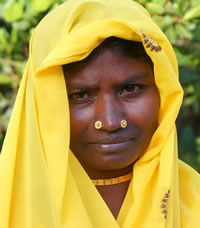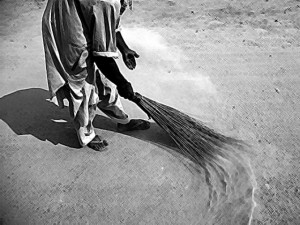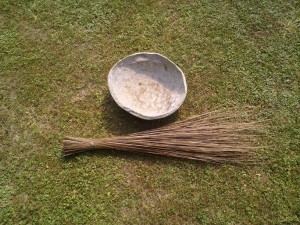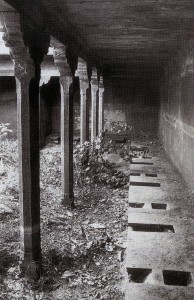THE SHIT CLEANERS OF LAHORE
CHANGING TIMES OF HYGIENE
A history of dealing with refuse
 The organism of man is related to input of energy requirements for his body, and the expulsion of refuse which his body no longer needs. The history of dealing with refuse is an interesting history of mankind. By design of Allah, the input has savoury smells, and the refuse has unwelcome odours. Various societies dealt with it in their own way, and archaeologists have uncovered the systems with time. In our region Mohenjo-daro was well advanced in its time, with a grand system of toilets. The dead sea scrolls tell us a different story. The monks living in caves had a system all their own. With a shovel in their hands, they would scrape a hole in the dust of the near mountain, squat on it and then fill it with mud. Later they had a pond in which they used to wash their feet. The Romans had public toilets, where men, women sat with each other in open enclosures, and talk their heart out on all subjects. English and French castles have their own tales to tell, where the Royalty were in the habit of defecating where and whenever they wanted. All these are fun for the archaeologist. From the survey of faeces of the dead sea scroll monks, they can research on what the monks ate at that time. Research is not always savoury for all.
The organism of man is related to input of energy requirements for his body, and the expulsion of refuse which his body no longer needs. The history of dealing with refuse is an interesting history of mankind. By design of Allah, the input has savoury smells, and the refuse has unwelcome odours. Various societies dealt with it in their own way, and archaeologists have uncovered the systems with time. In our region Mohenjo-daro was well advanced in its time, with a grand system of toilets. The dead sea scrolls tell us a different story. The monks living in caves had a system all their own. With a shovel in their hands, they would scrape a hole in the dust of the near mountain, squat on it and then fill it with mud. Later they had a pond in which they used to wash their feet. The Romans had public toilets, where men, women sat with each other in open enclosures, and talk their heart out on all subjects. English and French castles have their own tales to tell, where the Royalty were in the habit of defecating where and whenever they wanted. All these are fun for the archaeologist. From the survey of faeces of the dead sea scroll monks, they can research on what the monks ate at that time. Research is not always savoury for all.
 The Islamic way of life is often quoted in the saying that CLEANLINESS IS HALF OF FAITH ITSELF. That is why the Arabs invented the soap itself. The Muslim way of life including the ritual of regular baths and cleansing of the body. It is said that Europe hated the concept of bathing itself, and Europe existed for 1000 years with out bathing. Their rituals even today are very different from Islamic way of life. When Father Sebastian Manrique was in the palace of Nawab Asif Khan in Lahore in 1644, Emperor Shah Jahan was asked to comment on those Christians of his time. The Emperor including the following in his assessment of them. Shah Jahan said:
The Islamic way of life is often quoted in the saying that CLEANLINESS IS HALF OF FAITH ITSELF. That is why the Arabs invented the soap itself. The Muslim way of life including the ritual of regular baths and cleansing of the body. It is said that Europe hated the concept of bathing itself, and Europe existed for 1000 years with out bathing. Their rituals even today are very different from Islamic way of life. When Father Sebastian Manrique was in the palace of Nawab Asif Khan in Lahore in 1644, Emperor Shah Jahan was asked to comment on those Christians of his time. The Emperor including the following in his assessment of them. Shah Jahan said:
“Truly the Franguis would be great people, were it not for three grave faults; in the first place, they are Cafars (people without religion); in the second, they eat pork; and thirdly, they do not wash the parts which replete nature expels the excess of their material paunches.”
Turkish steam baths swept the world, and not only the palaces, but the entire city was full of ‘hammams’ to take baths and cleanse the body. Lahore had plenty of them. A look at the ladies toilets in the Red Fort Delhi tells us the system of the Mughal toilets. Similar ones existed in Lahore. Sir Thomas Herbert, Bart found it one of the most clean cities of the world in 1595 AD, as well as Richard Still and John Crowther in 1626 AD. The best cities of the world included Lahore for its clean and pure air. The system in most houses had ‘gurkis’, or small refuse wells. The refuse used to fall in these dumping holes in the ground. Either the sames were filled up and new gurkis dug, or they were cleaned after a year, or so.
The Sikh times brought in the break up of the the whole systems for reasons understood and at times not known. Out of the blues we have the city surrounded by small huts, houses, or fallen havellis in possession of the SHIT CLEANERS OF LAHORE. Ugly words were attached to them and ethnical they were termed as ‘Changars’. An ethnic race considered the lowest on the rung of the Hindu ladder of classes, and they were responsible for the dirtiest job of mankind. A few decades ago they could be easily seen, carrying a ‘PARAT’ or iron vessel, and moving from house to house. They would put the shit of every house in their parat and then dump it outside the city, from where it was collected in bull carts, and sold as fertilizer for vegetables sown outside the city. And the Shit-cleaners worked from generation to generation. Lest one may think that it was for poor people, even the description of travelers first class hotels in Lahore paint the same picture. A description given by an English traveler in the 19th century speaks the same story of Falettis hotel Lahore, here a better kind of Swedish basin was used for the purpose.

Lahore was serviced in water supply through big and small wells. Water need was also fulfilled by the water carrier (mashquis), who took water to the home of persons in a big hide skin vessel. The Mori system actually started with the making of the PANI WALA TALAB in Rang Mahal area, from where water was taken to the houses by a system of lead pipes. This changed the complexity of the city in total. With it came the Moris, open small gutters, and the bigger MORIS and the final MORI GATE itself. One of the Gates of Lahore is known as MORI GATE, or the GUTTER GATE, from where all the refuse of the city came out. The moat around the city was also used for the same purpose. And people may remember that these kind of MORIS were all there in the city, on which small children were seen shitting all the time. The elders used a small room at the top of the house. The whole city really stank and there was no reason to doubt same.

The Missionaries in our region did excellent work in rehabilitating many of such people. Being treated as human beings for the first time in thousands of years, the ‘Changars’ were ever grateful. Our hats off to these wonderful Monks and Nuns who gave the pride back to this community. Indeed God will bless them for their charity work and putting this community to useful tasks in the society. In the changing system of today, the Plumber remains important and the memory of the SHIT CLEANERS OF LAHORE ever there

The Lahori Imams also converted many of them into Islam as proven by documents existing to this day.